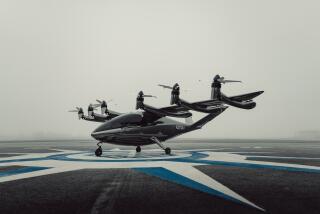To get supersonic business jets off the ground, Aerion Corp. is building planes that don’t go ‘boom’
- Share via
Plans to launch supersonic commercial jet travel have long been hampered by a U.S. ban on such flight over land.
But rather than limit routes to transoceanic travel, Aerion Corp. of Reno plans to push its AS2 supersonic business jet right to the limit — flying just a hair below supersonic when above ground, then speeding up to Mach 1.4 over water.
Maneuvering around that rule will be crucial for the handful of companies including Aerion that want to establish a market for supersonic business jets. Spike Aerospace Inc. of Boston is developing a needle-nose plane that would travel at Mach 1.6 and ferry 12 to 18 private passengers. Boom Technology Inc. of Englewood, Colo., plans to build a 55-seat supersonic airliner that would have a per-seat ticket cost on par with business-class travel.
Today’s supersonic jet manufacturers hope to avoid the problems that plagued the Concorde airliner, which flew for the last time in 2003. The Concorde was ultimately doomed by high maintenance costs, a soft market for air travel after the Sept. 11 attacks, and its high ticket price — as much as $18,260 for a London-to-New York round-trip flight, in 2017 dollars — which left many seats empty. Sonic-boom restrictions kept the Concorde on mostly transatlantic routes.
Technology improvements, including carbon-fiber composites known for their strength and light weight, could make the new jets more efficient. The Federal Aviation Administration has been working with other aviation organizations around the world to develop international noise and emissions standards for supersonic flight, but Aerion says its jet will be able to start flying without any rule changes.
“Part of our business case was we don’t require any regulatory changes to fly our airplane,” said Tom Vice, chief executive of Aerion, who previously served as president of Northrop Grumman Corp.’s aerospace systems sector in Redondo Beach. “It’s hard to convince somebody to buy an airplane and say, ‘We’ll get the laws changed.’”
The company intends to sell its planes for $120 million each, a price tag that would allow the company to pay back investors and invest in new technologies, Vice said. That is nearly twice the price of a high-end business jet, which can cost $60 million to $80 million. Aerion believes the savings in flying time — it plans to cut a flight from New York to Tokyo by 1 hour and 57 minutes — will justify the cost.
“Time is our most precious resource,” Vice said.
Aerion said it has already sold 23 aircraft, 20 of which will go to Flexjet, a Cleveland company that offers fractional jet ownership and leasing.
The business jet market shows the most promise for supersonic jets because large corporations and wealthy individuals are more likely to pay top dollar to save time, industry analysts said.
“Speed is not that high a priority for a commercial airline,” said Ray Jaworowski, senior aerospace analyst at market research firm Forecast International. “A supersonic business jet would be the ultimate prestige aircraft.”
And it has to be luxurious, Vice said. Aerion’s AS2 plane will have a large cabin that can fit as many as 12 passengers, putting it in the same size category as the Gulfstream G550 or the Dassault Falcon 7X. The wider fuselage design is known in aviation jargon as a “double bubble” and will allow for more foot space.
The entire aircraft will largely be made of carbon-fiber composites and is being designed to fly at Mach 1.2 without generating a sonic boom. The company has been working with Lockheed Martin Corp. on the air frame and aerodynamics since December.
Aerion had previously worked with Airbus Group on several design aspects, including structures and high-speed wind tunnel tests. That partnership ended last year. The European aviation giant wanted to learn more about how air flows over parts of the wing and was not interested in developing a supersonic business jet, said Bart Greer, an Airbus spokesman.
Aerion is also working with General Electric on the plane’s engine, which is composed of an existing engine core that was modified to allow for more efficient subsonic and supersonic flight, Vice said.
Developing an entirely new engine might deliver more speed, but it would be expensive, said R. John Hansman, professor of aeronautics and astronautics at MIT.
“You’re paying a performance penalty for that, but it makes total sense,” he said.
The company has started to scale up ahead of a first flight in 2023. Aerion has 43 employees but is planning to hire 20 to 30 new executives, senior engineers and directors at a hiring event in Southern California this month, Vice said.
Aerion’s long-term plan envisions possibly developing a larger commercial supersonic airliner, which could start off as a 24-seater and evolve into 100 to 150 seats, though Vice cautioned that could be many years in the future.
In the meantime, the field is growing more crowded. Boom, whose supersonic jet would carry more passengers and is aimed at ticketed commercial service, has already secured a $10-million investment and a 20-aircraft pre-order from Japan Airlines, as well as pre-orders from British billionaire Richard Branson’s Virgin Group.
“Whoever gets in there first with a credible design and robust marketing plan and gets those crucial initial orders and gets well on the road to entering production and entering service, they may have a big leg up on their prospective competition,” said Jaworowski of Forecast International.
Twitter: @smasunaga
More to Read
Inside the business of entertainment
The Wide Shot brings you news, analysis and insights on everything from streaming wars to production — and what it all means for the future.
You may occasionally receive promotional content from the Los Angeles Times.











